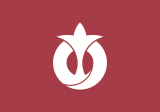


Prefecture flag
Main City: Nagoya
Population: 7,484,000 people, ranking 4/47 prefectures (2015) [1]
Area: 5,153 km2 [2]
Geographical / Landscape description:
Located near the centre of the Japanese main island of Honshu, Aichi Prefecture faces the Ise and Mikawa Bays to the south and borders Shizuoka Prefecture to the east, Nagano Prefecture to the northeast, Gifu Prefecture to the north, and Mie Prefecture to the west. The highest spot is Chausuyama at 1,415 m above sea level.
The western part of the prefecture is dominated by Nagoya, Japan's third largest city, and its suburbs, while the eastern part is less densely populated, but still contains several major industrial centres.
As of 1 April 2012, 17% of the total land area of the prefecture was designated as Natural Parks. [2]
Climate:
Aichi prefecture’s climate is generally mild, since located in a plain, Nagoya can be record some relative hot weather during summer. [2]
Recent history, culture:
Aichi prefecture is proud to be the birth place of three main figures that led to the unification of Japan between the 16th and 17th century: Oda Nobunaga, Toyotomi Hideyoshi, and Tokugawa Ieyasu. Due to this, Aichi is sometimes considered as the home of the samurai spirit. Many commemorative museums and places can be found in the prefecture retracing the history behind the three figures.
In 2005 Aichi hosted the universal exposition. [2][3]
More chapters:
The EU-Japan Centre currently produces 5 newsletters :










Joint venture established in 1987 by the European Commission (DG GROW) and the Japanese Government (METI) for promoting all forms of industrial, trade and investment cooperation between the EU and Japan.
The EU-Japan Centre’s activities are subject to the allocation of a Grant Agreement by the European Commission for 2024-2026

